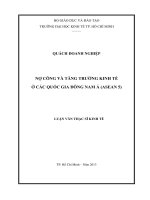Tác động của nợ công và lạm phát đến tăng trưởng kinh tế ở các nước piigs
Bạn đang xem bản rút gọn của tài liệu. Xem và tải ngay bản đầy đủ của tài liệu tại đây (1.99 MB, 217 trang )
中图分类号
..
学校代码 10512
博士学位论文
P h D D I S S E RTAT I O N
“欧债五国”公共债务、通货膨胀对
经济增长的影响研究
研 究 生 :NGUYEN THI THU HANG
导
师 :朱小梅
专
业 :世界经济
研究方向:国际金融
中国武汉
WUHAN, CHINA
2020 年 5 月
分类号:F124.3
学校代码:10512
学 号: 201707111200001
秘密☆ 年
湖北大学博士学位论文
“欧债五国”公共债务、通货膨胀对
经济增长的影响研究
作者姓名:NGUYEN THI THU HANG 指导教师姓名、职称:朱小梅教授
合作导师姓名、职称:
申请学位类别:经济博士
研究方向
学科专业名称
:世界经济
:国际贸易
论文提交日期:2020 年 03 月 20 日
论文答辩日期:2020 年 05 月 30 日
学位授予单位:
学位授予日期:
答辩委员会主席: ________________
年 月 日
Research on the impact of public debt and inflation on
economic growth in the PIIGS
A Dissertation Submitted for the Doctor Degree
Candidate: NGUYEN THI THU HANG
Supervisor: Prof. Xiaomei Zhu
Hubei University
Wuhan, China
学位论文使用授权书
本论文作者完全了解学校关于保存、使用学位论文的管理办法及规定,即学校有权保留并向国
家有关部门或机构送交论文的复印件和电子版,允许论文被查阅和借阅。本人完全同意《中国博士
学位论文全文数据库出版章程》、《中国优秀硕士学位论文全文数据库出版章程》(以下简称“章
程”,见 www.cnki.net),愿意将本人的学位论文提交中国学术期刊(光盘版)电子杂志社在《中国
博士学位论文全文数据库》、《中国优秀硕士学位论文全文数据库》中全文发表和以电子、网络及
其他数字媒体形式公开出版,并同意编入 CNKI《中国知识资源总库》,在《中国博硕士学位论文
评价数据库》中使用和在互联网上传播,同意按“章程”规定享受相关权益(请作者直接与杂志社联
系,联系人:栗老师;电话:010-62791817、62793176、62701179;通讯地址:北京 清华大学邮
局 84-48 信箱 采编中心 邮编:100084)。
本授权书签署一式三份,交研究生处学位办。
学位论文作者签名:
导师签名:
年 月 日
年 月 日
湖北大学研究生学位论文作者信息
论文题目
公共债务与通货膨胀相互作用对经济增长的影响研究——以欧债危机国为例
NGUYEN THI THU
姓 名
HANG
院
联系电话
201707111
答辩日期
2020 年 05 月 29 日
200001
博士 √ 硕士□
论文级别
学
学号
湖北大学商学院
15271918396
专
业
作者 E-mail
世界经济
作者通信地址(含邮编):
备注:
注:本论文如需保密,解密时间是 年 月。(保密学位论文在解密后适用于本授权
ABSTRACT
After the outbreak of the US financial crisis in 2008, the economies of many countries
around the world were severely impacted. In response to the impact of the crisis, many
countries and regions have implemented expansionary fiscal policies to stimulate the
economy, such as using debt (internal debt and external debt) to alleviate the shortage of
domestic capital. These measures not only have some positive effects, such as improving
jobs and increasing national income, but have also caused more significant negative impacts
on these countries, such as excessive debt burdens, rising inflation rates, and declining
economic growth rates. Among these countries and regions where the debt crisis has
occurred, the European debt crisis is highly representative. The European debt crisis started
in Greece in 2009, and then quickly spread to other countries in the Eurozone. Portugal,
Ireland, Italy, Greece, and Spain have the most severe public debt situations. These five
countries are also called the PIIGS. The GDP of the PIIGS accounts for one-third of the
Eurozone, but they are also the weakest economies in this area. They faced enormous debt
pressure before the debt crisis, and their budget deficits were far exceeded the threshold of
EU regulation. The high public debts of these five countries have not only greatly affected
the economies of their own countries and the Eurozone, but also brought serious challenges
to the stability of the world economy and global financial markets. To reduce the impact of
the public debt crisis, the governments of the PIIGS have taken many measures to control
the debt crisis and its secondary problems. To avoid conflicts between reducing public debt,
stabilizing prices, and maintaining economic growth, the governments of the five countries
have taken many measures to coordinate monetary and fiscal policies. By 2014, the debt
crisis in Europe, including these five countries, had declined to some extent. In this context,
public debt issues, including the European debt crisis, have become hot topics of concern
for governments, businesses, and academia. Studying the problems related to the public debt
I
and economic growth of the European debt crisis countries, especially the PIIGS, can
provide a specific reference for countries with high public debt and also help expand the
research in related fields.
This thesis selects the PIIGS as the research object, and analyzes the impact of public
debt and inflation on the economic growth of these countries. This thesis is based on the
economic development of the PIIGS before, during, and after the European debt crisis to
facilitate better research, and focuses on studying the effects of public debt and inflation on
economic growth of the PIIGS during the European debt crisis. Therefore, the research
period selected in this thesis is from 1999 (at the time of the Eurozone's establishment) to
2018. Firstly, based on a review of relevant literature, this thesis analyzes the situation of
public debt, inflation, and economic growth of the PIIGS from 1999 to 2018, focusing on
the occurrence, development, and recovery of the public debt crises in these countries.
Secondly, this thesis analyzes the theory of the impact of public debt and inflation on
economic growth in the PIIGS and proposes the following hypotheses for three main
variables: public debt has certain negative effects on the economic growth of these five
countries; Inflation has a certain positive impact on the economic growth of these five
countries; Considering that there is a certain correlation between public debt and inflation,
this thesis assumes that the interaction between public debt and inflation may have an
impact on the economic growth of these five countries. Based on the above theoretical
analysis, this thesis uses PMG and the revised CSD and CCE estimation methods to conduct
empirical research on the impact of public debt and inflation on the economic growth of the
PIIGS. The result shows: (1) The public debts of the PIIGS have had a significant negative
impact on their economic growth. The debt burden of these countries is severe, and
repayment is very difficult. At the same time, because these countries use government loans
mainly for expenditure, and rarely use loans for investment to improve national productivity.
Therefore, high public debt and long-term fragile financial management have reduced
domestic savings, government spending cannot create real value for the economy, and labor
productivity declines, leading to a decline in economic growth. (2) Inflation has had a
specific positive impact on the economic growth of the PIIGS. After the debt crisis, the
inflation rates of these five countries have all increased, and real GDP has also increased to
a certain extent. Of course, the economic recovery and growth of these countries may also
be related to other stimulus policies adopted by their governments and the assistance
provided by the European Union and the IMF. (3) There is a certain correlation between
public debt and inflation, and the interaction between public debt and inflation has a certain
negative impact on the economic growth of these five countries, which may be due to the
public debt is not used more for investment. As a result, the negative impact of the high
public debt on economic growth is more significant than the positive impact of inflation on
economic growth, making the combined effect of the two variables on the economic growth
negative. In particular, it is worth mentioning that when analyzing the impact of public debt
on the economic growth of the PIIGS, this thesis found that public debt has a negative
impact on the economic growth of these five countries in the short term, but has a positive
effect in the long term. This thesis further shows that fiscal consolidation based on reducing
expenditures is more efficient and has a better impact on long-term growth than fiscal
policies based on increasing revenue. In particular, tight fiscal policy is effective at reducing
recurrent spending instead of reducing spending on education, research, and innovation. It
can see: After the crisis, the PIIGS continued to implement fiscal austerity policies and cut
irrational expenditures, especially recurrent expenditures. These measures have restored the
economic growth of most of the five countries.
Based on the above research, this thesis gives specific policy recommendations for the
the PIIGS and the European Union to promote economic growth in coordinating and
controlling public debt and inflation. The thesis shows that the PIIGS need to publish
information on national budgets and public debts, be cautious about borrowing, strengthen
III
public debt management, increase budget revenue, cut public expenditure, and continue to
develop the domestic debt market to promote economic growth. This thesis also gives
relevant suggestions based on the specific economic development of the PIIGS. From a
European perspective, this thesis believes that the Union needs to: implement more flexible
monetary policies in conjunction with the fiscal policies of the Eurozone member countries,
design corresponding currency operation, and management mechanisms, and strengthen
supervision, expand the group's overall budget and the stabilize fund.
Key Words: the PIIGS; public debt; inflation; economic growth; European debt crisis
摘要
2008 年美国金融危机爆发后,世界各国经济受到了严重的冲击。为了应对危机的
影响,许多国家和地区实行了扩张性的财政政策以刺激经济,如以举债(内债和外债)
来缓解国内资金不足。这些措施既产生了一些积极效应,如改善了就业,增加了国民
收入,但是也给这些国家造成了较大的负面影响,如债务负担过重,通货膨胀率上升,
经济增长速度下降等。在这些发生债务危机的国家和地区中,欧洲债务危机具有较强
的代表性。欧洲债务危机 2009 年发端于希腊,然后迅速蔓延到欧元区其他国家,其中
葡萄牙、爱尔兰、意大利、希腊和西班牙的公共债务状况最为严重,这五个国家也因
此被称为“欧债五国”。“欧债五国”的 GDP 占欧元区的三分之一,但它们也是欧元区经
济最为薄弱的几个国家,在债务危机发生前就它们就面临着很大的债务压力,预算赤
字远远超过了欧盟监管的门槛。这五个国家的高额公共债务,不仅对本国及欧元区的
经济造成了极大的影响,也对世界经济和全球金融市场的稳定带来了严重的挑战。为
了减少公共债务危机的影响,“欧债五国”政府采取了许多措施以控制债务危机及其引
发的次生问题。为了避免减少公共债务、稳定物价与保持经济增长之间的冲突,这五
个国家的政府都采取了许多措施以协调货币政策和财政政策。直到 2014 年,包括这五
国在内的欧洲地区的债务危机才得到了一定程度的缓解。在此背景下,包括欧洲债务
危机在内的公共债务问题成为各国政府、企业和学界关注的热点问题。研究欧债危机
国家尤其是“欧债五国”公共债务及经济增长的相关问题,可以为目前具有较高公共债
务的国家提供一定的参考借鉴,也有助于拓展相关领域的研究。
本文以“欧债五国”为研究对象,探讨其公共债务、通货膨胀对这几个国家经济增
长的影响。为便于更好地开展相关研究,本文以欧债危机发生前、发生过程中以及发
生后三个阶段“欧债五国”经济发展的状况为背景,重点研究了欧债危机发生过程中这
五个国家的公共债务、通货膨胀状况及其对经济增长的影响,因此本文选取的时间段
为 1999 年(即欧元区成立的时间)到 2018 年。本文在梳理相关文献的基础上,首先
对 1999-2018 年“欧债五国”的公共债务、通货膨胀以及经济增长情况进行了分析,重点
V
分析了这几个国家公共债务危机的发生、发展和复苏情况。其次,本文对“欧债五国”
公共债务、通货膨胀对其经济增长的影响进行了理论分析,并针对这三个变量提出以
下假设:公共债务对这五个国家的经济增长有一定的负面影响;通货膨胀对这五个国
家的经济增长有一定的正面影响;考虑到公共债务和通货膨胀存在着一定的相关性,
本文假设二者的相互作用有可能会对这五国的经济增长产生影响。在上述理论分析的
基础上,本文采用了 PMG 和修订后的 CSD 与 CCE 估算法,对“欧债五国” 公共债务、
通货膨胀对其经济增长的影响进行了实证研究。结果表明:(1)“欧债五国”的公共债
务对其经济增长都产生了较大的负面影响。这些国家债务负担非常严重,还款难度很
大,同时由于相关国家把政府贷款主要用于支出,而很少把贷款用于投资以提高国民
生产力,因此,高企的公共债务,长期脆弱的财务管理使国内储蓄减少,政府支出不
能为经济创造真正的价值,劳动生产率下降,导致经济增长下滑。(2)通货膨胀对
“欧债五国”的经济增长产生了一定的积极影响,债务危机发生后,这五个国家的通货
膨胀率都有所上升,而实际 GDP 也出现了一定程度的增长。当然这几个国家的经济复
苏和增长可能还与其政府采取的其他刺激经济政策及欧盟、IMF 等提供的援助有关。
(3)公共债务与通货膨胀之间存在一定的相关性,二者在一定程度上的相互作用对这
五个国家的经济增长产生了一定的负面影响,这可能是由于这几个国家的公共债务没
有更多地用于投资,导致其巨额公共债务对经济增长的负面影响大于通货膨胀对经济
增长的正面影响,使得两者共同作用对经济增长的净影响为负。值得一提的是,本文
在分析公共债务对“欧债五国”经济增长的影响时发现,短期内公共债务对这五国的经
济增长有负面影响,但在长期内有积极作用,因此本文进一步认为:当预算约束适用
于经常性支出而不是用于教育、研究和创新性投资时,减少支出的财政政策比增加收
入的财政政策更有效,对长期经济增长的影响也更大。危机后的“欧债五国”不断实施
紧缩的财政政策,削减不合理的支出,尤其是经常性支出,这些举措使得五国中多数
国家的经济恢复了增长。
在上述研究的基础上了,本文对“欧债五国”及欧盟在协调控制公共债务和通货膨
胀以促进经济增长方面提出了具体的政策建议,认为,“欧债五国”有必要公布国家预
算和公共债务的相关信息,对借款应持谨慎态度,加强公共债务管理,增加预算收入,
削减公共支出,继续发展国内债务市场以推动经济增长。本文还根据近年来“欧债五国”
经济发展的具体情况,分别提出了相关建议。从欧盟整体来看,本文认为该集团需要
结合欧元区成员国的财政政策,实施更为灵活的货币政策,并设计相应的货币运行、
管理机制,加强监管;扩大集团的整体预算和稳定基金。
关键词:“欧债五国”;公共债务;通货膨胀;经济增长;欧洲债务危机
VII
Contents
ABSTRACT .................................................................................................................. I
摘要 ............................................................................................................................. V
LIST OF FIGURES ................................................................................................... XI
LIST OF TABLES ....................................................................................................XII
LIST OF APPENDICES ......................................................................................... XIV
Chapter 1 Introduction ............................................................................................. 1
1.1 Research background and research significance .................................................... 1
1.1.1 Research background .......................................................................................... 1
1.1.2 Research significance .......................................................................................... 7
1.2 Literature review .................................................................................................... 9
1.2.1 Literature review of domestic studies ................................................................. 9
1.2.2 Literature reviews of foreign studies ................................................................ 23
1.3 Research content and research method ................................................................ 49
1.3.1 Research content ............................................................................................... 49
1.3.2 Research method ............................................................................................... 50
1.4 Innovations and limitations of the thesis.............................................................. 52
1.4.1 Innovations of the thesis ................................................................................... 52
1.4.2 Limitations of the thesis .................................................................................... 53
Chapter 2 Overview of related theories ................................................................ 55
2.1 The theory of the interaction between public debt and inflation ......................... 55
2.1.1 The theory of the impact of public debt on inflation ........................................ 55
2.1.2 The theory of the impact of inflation on public debt ........................................ 56
2.2 The theory of the impact of the interaction between public debt and inflation on
economic growth ........................................................................................................ 58
2.2.1 The theory of the impact of public debt on economic growth .......................... 58
2.2.2 The theory of the impact of inflation on economic growth .............................. 59
2.2.3 The arguments on the interaction effects of public debt and inflation on
economic growth ........................................................................................................ 60
2.3 Relevant theories about economic growth and the factors affecting economic
growth ........................................................................................................................ 62
2.3.1 Relevant theories of economic growth .............................................................. 62
2.3.2 Relevant theory of factors affecting economic growth ..................................... 68
Chapter 3 Public debt, inflation and economic growth in the PIIGS ................ 75
3.1 Overview of public debt, inflation, economic growth in the Eurozone ............... 75
3.1.1 Overview of public debt, inflation, economic growth in the Eurozone before the
crisis of European public debt (1999-2008) ............................................................... 77
3.1.2 Overview of public debt, inflation, economic growth in the Eurozone during
the European public debt crisis (2009-2014) ............................................................. 78
3.1.3 Overview of public debt, inflation, economic growth in the Eurozone after the
European public debt crisis (2015 – present) ............................................................. 79
3.2 Overview of public debt, inflation, economic growth in the PIIGS .................... 82
3.2.1 Greece ............................................................................................................... 84
3.2.2 Portugal ............................................................................................................. 91
3.2.3 Spain.................................................................................................................. 96
3.2.4 Italy ................................................................................................................. 103
3.2.5 Ireland ............................................................................................................. 109
Chapter 4 The empirical analysis on the impact of public debt and inflation on
the economic growth of the PIIGS ........................................................................ 125
4.1 Measurement model setting ............................................................................... 125
4.2 Data description and variable selection ............................................................. 130
4.2.1 Data description .............................................................................................. 130
4.2.2 Variable selection ............................................................................................ 130
4.3 Model selection and test ..................................................................................... 136
4.3.1 The causal relationship between public debt, inflation, and economic growth
.................................................................................................................................. 137
4.3.2 The impact of the interaction between public debt and inflation on growth ..141
4.4 Empirical results and analysis ............................................................................ 146
4.4.1 Import and process data: global, import, reshape, merge ............................... 146
IX
4.4.2 Descriptive statistics ....................................................................................... 146
4.4.3 The correlation matrix between variables in the model .................................. 147
4.4.4 Panel unit root test........................................................................................... 148
4.4.5 Co-integration test ........................................................................................... 148
4.4.6 Causality test ................................................................................................... 149
4.4.7 The estimated results of the PMG model on the impact of public debt and
inflation on the economic growth of the PIIGS ....................................................... 150
4.4.8 Test cross-correlation (CSD) and common factor (CCE) .............................. 154
4.4.9 Fixing CSD, CCE .............................................. Error! Bookmark not defined.
Chapter 5 Conclusions, policy recommendations, and research prospects ..... 158
5.1 Conclusion ......................................................................................................... 158
5.2 Policy recommendations .................................................................................... 160
5.2.1 General policy recommendations for the PIIGS ............................................. 162
5.2.2 Specific policy recommendations for the PIIGS ............................................. 167
5.2.3 Policy suggestions for the EU ......................................................................... 179
5.3 The direction of future research ......................................................................... 181
Main References ...................................................................................................... 182
LIST OF APPENDICES .......................................................................................... 193
ACKNOWLEDGEMENTS ..................................................................................... 199
LIST OF FIGURES
Figure 1.1: Public debt of the PIIGS in the period 1999 – 2018 ···································· 2
Figure 1.2: Inflation rate of the PIIGS in the period 1999 – 2018 ·································· 3
Figure 1.3: GDP growth rate of the PIIGS in the period 1999-2018 ······························· 4
Figure 1.4: The research content of the thesis ······················································· 50
Figure 2.1: Factors affecting economic growth ····················································· 68
Figure 2.2: Three-gap model ··········································································· 73
Figure 3.1: Public debt, inflation and economic growth of the Eurozone from 1999 to 2018· 77
Figure 3.2: Public debt, inflation and economic growth of the PIIGS from 1999 to 2018····· 83
Figure 3.3: Public debt, inflation and economic growth of Greece from 1999 to 2018 ········ 86
Figure 3.4: Public debt, inflation and economic growth of Portugal from 1999 to 2018 ······ 92
Figure 3.5: Public debt, inflation and economic growth of Spain from 1999 to 2018 ·········· 98
Figure 3.6: Public debt, inflation and economic growth of Italy in the period 1999 - 2018 · 104
Figure 3.7: Public debt, inflation and economic growth of Ireland in the period 1999 - 2018111
Figure 4.1: The process of selecting estimated models ··········································· 136
XI
LIST OF TABLES
Table 3.1: Average debt value of the PIIGS in 3 periods: before, during and after the
European public debt crisis ··········································································· 118
Table 3.2: Average inflation value of the PIIGS in 3 periods: before, during and after the
European public debt crisis············································································ 118
Table 3.3: Average economic growth value of the PIIGS in 3 periods: before, during and after
the European public debt crisis ······································································· 119
Table 3.4: Average unemployment value of the PIIGS in 3 periods: before, during and after
the crisis of European public debt ··································································· 119
Table 3.5: Summary of public debt, inflation and economic growth of the PIIGS in the period
1999 – 2018 ····························································································· 120
Table 4.1: Describe the variables in the research model ·········································· 135
Table 4.2: Unit root tests for balanced panel data ················································· 138
Table 4.3: Assumptions about the trend of the impact of variables in the proposed
experimental model ···················································································· 145
Table 4.4. Statistics describe the variables in the empirical model······························ 146
Table 4.5: The correlation matrix between variables in the model ······························ 147
Table 4.6: Results of stationarity tests by Hadri test for main data series ······················ 148
Table 4.7: Test results of the co-integration relationship between GDP and DEBT ·········· 148
Table 4.8: Test results of the co-integration relationship between DGDP and INFL ········· 149
Table 4.9: Test results of the causal relationship between GDP and DEBT ··················· 149
Table 4.10: Test results of the causal relationship between GDP and INFL ··················· 149
Table 4.11: The estimated results of the PMG model on the impact of public debt and
inflation on the economic growth of the PIIGS ··················································· 151
Table 4.12: Results of cross-dependency tests between table units ····························· 154
Table 4.13: The estimated results of fixing CSD, CCE on the impact of public debt and
inflation on the economic growth of the PIIGS ··················································· 155
Table 4.14: Summary of estimated results on the impact of public debt and inflation on the
economic growth of the PIIGS by 2 methods······················································ 157
Table 5.1: Greece's tax rates until 2019 ····························································· 171
XIII
LIST OF APPENDICES
Appendix 1: Results of stationarity tests for major chains..................................................... 193
Appendix 2: Test results of the co-integration relationship between GDP and DEBT, INFL196
Appendix 3: Results of the Hausman test to choose the PMG model and MG model ......... 196
Appendix 4: The estimated results of the PMG model .......................................................... 197
Appendix 5: Estimated results after overcoming CSD and CCE ........................................... 198
湖北大学 博士论文
Chapter 1 Introduction
1.1 Research background and research significance
1.1.1 Research background
Public debt is not a new topic but has become a current hot issue for the research
academics.
The reality of global economic developments over the past few decades showed that
public debt had brought enormous benefits to many countries. It is undeniable that the role of
public debt in providing capital to ensure the investment needs of countries, public debt is the
Government's tool to implement monetary policy more standardized and stable, and actively
contribute to promoting the process of international economic integration.
However, the massive and rapidly rising debt in some countries around the world shows
a negative impact on the domestic economic growth, financial markets, and the stability of the
macroeconomic environment. Excessive increases in public debt will raise interest rates,
increase inflation pressures, and adversely affect exchange rates, thereby creating a trade
deficit and slowing economic growth, which even can lead to global financial crises and
economic crises. In reality, there have been public debt crises in the world that have
significantly affected the economic stability of not only one country but also the global
economy, such as the European public debt crisis, the Public debt crisis in the US, the Public
debt problem in Japan.
After the outbreak of the US financial crisis in 2008, the world faced a big debt crisis,
which was the European public debt crisis between 2009 and 2014. The European debt
crisis originated in Greece and then quickly spread other countries in the Eurozone. The five
countries with the most worrying public debt status in Europe's public debt crisis are
Portugal, Ireland, Italy, Greece, and Spain. These countries put into a group called the
PIIGS, which stands for a barnyard animal known for its mud, dirt, and unpleasant smell.
The term itself is not an official title, nor does it separate these countries from the European
1
第一章 前言
Union (EU). The term became a convenient way for currency traders and global investors to
group these countries. The PIIGS group contributes one-third of GDP to the Eurozone and
is also the group of countries with the weakest economies in the region. The PIIGS's high
public debt has raised concerns about international public debt and the stability of the global
financial market.
Public debt to GDP ratio (%)
250
200
150
100
50
Before the European public debt crisis
2018
2017
2016
2015
2014
2013
2012
2011
2010
2009
2008
2007
2006
2005
2004
2003
2002
2001
2000
1999
0
During the European public After the European
debt crisis
public debt crisis
Greece
Portugal
Spain
Ireland
Italy
Average debt of PIIGS
Average debt of Eurozone
Figure 1.1: Public debt of the PIIGS in the period 1999 - 2018
Source: International Financial Statistics (IMF)
Figure 1.1 above shows that the average public debt of PIIGS in all three periods
( before the crisis, during the crisis, and after the crisis) is always higher than the average
Eurozone public debt. Before the EU public debt crisis, the average public debt of PIIGS was
higher than 60%. Especially in the PIIGS group, there are two typical countries: Greece and
Italy have always maintained public debt ratios higher than 100% right before falling into
crisis. During the crisis period, the public debt of all countries in the PIIGS group increased
sharply, reaching its peak in 2014: Greece (180.22%), Italy (131.784%), Portugal (130.593%),
Spain (100.367%), Ireland (in 2012 with 119.731%). After the crisis, although the average
湖北大学 博士论文
public debt of PIIGS tended to decrease slightly, but it was all over 120% (in 2015 with a
public debt ratio of 123.111%, in 2016: 123.456%, in 2017: 121.173%, in 2018: 121.217%)
and far exceeded the average public debt ratio of PIIGS in the period before the crisis. While,
after the crisis, the average public debt ratio of the Eurozone was less than 80% ( in 2015:
79.453%, in 2016: 78.823%, in 2017: 76.202%, in 2018: 74.62%). Public debt of countries in
the PIIGS group in 2018 was as follows: Greece (191.271 %), Italy (129.745%), Portugal
(121.244%), Spain (96.708%).
Notably, Ireland before falling into the crisis had the lowest public debt ratio compared
to the countries in the PIIGS group and lower than the average public debt ratio of the
Eurozone. However, in the crisis period, the public debt of Ireland had the fastest growth rate
( reflected by the slope of the public debt line) and far exceeded the average Eurozone public
debt ratio. After the crisis, Ireland's public debt decreased significantly to a level lower than
the average Eurozone public debt. Ireland is the only country in the PIIGS group in a short
time miraculously overcome the debt crisis. Greece always had the highest rate of public debt
among PIIGS in all three periods before the crisis, during the crisis, and after crisis.
8
4
2
-4
Before the European public debt crisis
2018
2017
2016
2015
2014
2013
2012
2011
2010
2009
2008
2007
2006
2005
2004
2003
2002
2001
-2
2000
0
1999
Inflation rate (%)
6
During the European public
After the
debt crisis
European public
debt crisis
-6
Greece
Portugal
Spain
Ireland
Italy
Average inflation rate of Eurozone
Figure 1.2: Inflation rate of the PIIGS in the period 1999 - 2018
Source: World Development Indicators (World Bank)
3
第一章 前言
Figure 1.2 shows, in the period before the global financial crisis 2007-2008, the inflation
rate of the PIIGS group fluctuated slightly and always stayed at above 2%, fluctuating around
the average inflation rate of the Eurozone. Until the global financial crisis took place, the
inflation rates of countries in this group fluctuated sharply. In 2009, the same year that the
countries in the PIIGS group had just fallen into the crisis of European public debt, inflation
dropped since 1999, specifically: Greece (1.21%), Italy (0.775%), Portugal (-0.836%), Spain
(-0.288%), Ireland (-4.4781%). During the crisis, the countries in the PIIGS group were in a
state of deflation for a few years. After the crisis, due to the consequences of the public debt
crisis, most countries in the PIIGS are still deflationary. Until 2017 and 2018, the inflation
rate of PIIGS increased again and was well controlled at the 2% target set by the ECB.
It can be seen that Ireland's inflation rate was most affected by the global financial crisis
of 2007-2008 and the public debt crisis of 2009-2014. Ireland's inflation increased and
decreased most strongly compared to the rest of the PIIGS countries and compared with the
average inflation rate of the Eurozone.
25
20
15
10
5
-10
Before the European public debt crisis
-15
During the European
public debt crisis
After the
European public
debt crisis
Greece
Portugal
Spain
Ireland
Italy
Average economic growth rate in PIIGS
Average economic growth rate of PIIGS
Figure 1.3: GDP growth rate of the PIIGS in the period 1999-2018
Source: World Development Indicators (World Bank)
2018
2017
2016
2015
2014
2013
2012
2011
2010
2009
2008
2007
2006
2005
2004
2003
2002
2001
-5
2000
0
1999
Economic growth rate (%)
30
湖北大学 博士论文
Figure 1.3 shows that, before the crisis, the average growth rate of PIIGS was
sometimes higher than that of the Eurozone. However, during the crisis period, this rate was
mostly lower, even having negative values in 4 consecutive years from 2009 to 2013 ( in 2009:
-4.788%, in 2010:-0.29%, in 2011: -1.671%, in 2012:-3.35%, in 2013:-1.313%). The
economy of the PIIGS group has been in severe decline, and recession during the crisis:
Greece's GDP growth rate in 2011 was -9%, Ireland's in 2008 was -6.33%, Italy's 2009 was 5.912 %, Spain's 2009 was -4.424%, and Portugal's 2012 was -3.638%. After the crisis, due to
the recovery of PIIGS countries, and mainly due to the phenomenal growth of Ireland, the
average growth rate of PIIGS is always higher than Eurozone. The economic growth of
countries in the PIIGS group in 2018 was as follows: Greece (2.191 %), Portugal (2.329%),
Spain (2.295%), Ireland (5.64%), Italy (1.034%).
Notably, Greece's economy most heavily affected by the debt crisis. Before the crisis,
Greece had the second-highest average economic growth (3.17%) among the PIIGS, only
after Ireland (3.265%). However, the public debt crisis has made Greece's economy grow at
the lowest level in the PIIGS group (average economic growth during the crisis period was 4.512% and after the crisis was 1.086%). Ireland in 2015 had a period of phenomenal growth
and the highest growth rate as of 2018 in the PIIGS countries. The average growth rate in
Ireland during this period was 9.86%. Italy always had weak economic growth among PIIGS
in all three periods before the crisis, during the crisis, and after the crisis.
The situation of public debt, inflation, and economic growth of PIIGS countries in the
period of 1999-2018 above shows that the excessive increase of public debt has a negative
impact on economic growth. To overcome the consequences of the public debt crisis, the
governments of the PIIGS countries have to deal with many difficulties at the same time. In
principle, to increase economic growth and reduce unemployment, investment and spending
must be increased. Therefore, public debt will continue to increase. While to reduce public
debt, countries have had to implement austerity policies by cutting spending and raising taxes.
5
第一章 前言
If the government reduces spending too sharply, the economy will plummet very quickly,
leading to a sharp decline in tax revenue and an increasingly fragile ability to repay debts.
Therefore, if economic growth is adversely affected, the fiscal sustainability problem is
exacerbated, which increases the cost of fiscal adjustment efforts to reduce the debt at more
sustainable levels. At the same time, sustained increases in output at low inflation levels are
the primary goal of the vast majority of macroeconomic policies. Price stability is the main
factor in determining economic growth; therefore, the monetary authorities of nations enforce
monetary policies to maintain inflation at a desired level. To avoid conflicts between reducing
public debt targets, stabilizing prices, and maintaining economic growth targets, governments
of countries tried to coordinate monetary policies and fiscal policies rationally. Therefore,
studying the impact of the interaction between public debt and inflation on economic growth
in the same study can provide more comprehensive recommendations for governments in
countries with high public debt today.
From the literature review can see, there has been little research and analysis on the
relationship between public debt, inflation, and economic growth in the academic field.
Chudik et al. (2013) and Lopes da Veiga et al. (2015) assessed the simultaneous effects of
public debt and inflation on economic growth but had not studied the impact of this
interaction variable on economic growth. Then, Akitoby et al. (2014) pointed out that in
addition to the direct impact of public debt and inflation on economic growth, there may be an
interaction effect on economic growth, but the author has not conducted empirical research.
Later, Nguyen Van Bon (2016) pointed out that public debt and inflation had a two-way
relationship and their interaction had a positive effect on economic growth for 60 developing
countries from 1990 to 2014.
Thus, the practical and academic research background shows that the interaction
between public debt and inflation can have a specific impact on economic growth. In
particular, the interaction effect between public debt and inflation on economic growth is an
湖北大学 博士论文
unknown issue. Therefore, it is meaningful and urgent to clarify this issue. This thesis has
selected the research object as the PIIGS because it includes the five most typical debt crisis
countries in the EU. At the same time, the thesis researches in the period from the countries
joining the Eurozone (1999) to 2018. Finally, the author chose: “Research on the impact of
public debt and inflation on economic growth in the PIIGS”as a research topic.
This thesis clarifies the following three main contents for the PIIGS from 1999 to 2018:
(1) Overview of public debt, inflation, and economic growth
(2) The impact of the interaction between public debt and inflation on economic growth
(3) Policy recommendations for the PIIGS countries and EU
1.1.2 Research significance
(1) Theoretical significance
① Through the analysis of related growth theories, the thesis finds that there is still
much debate among theories about the factors leading to income disparities between countries.
Therefore, there were disagreements about the factors leading to economic growth. Besides,
the model of public debt and inflation related to economic growth has not studied in depth.
Therefore, based on the empirical analysis framework, this thesis clarifies the impact of
the interaction between public debt and inflation on economic growth. It is thereby
contributing to research further the theory of public debt, inflation, and the interaction of
public debt and inflation to growth to supplement scientific evidence for the field of research
on this topic.
② This study is a new study on the effects of public debt and inflation on the growth of
PIIGS countries. Therefore, the results from the empirical analysis and evaluation of this
thesis contribute to the academic research of countries that have fallen into public debt crisis
or have high public debt, thereby forming the basis for the reasoning of other relevant studies.
(2) Realistic significance
① According to the IMF and the World Bank, the world public debt is at a record. The
7









